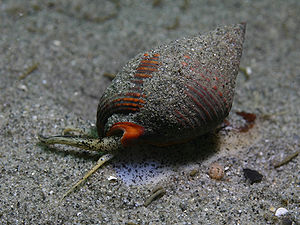Hypsogastropoda
| Hypsogastropoda | ||||||||||||
|---|---|---|---|---|---|---|---|---|---|---|---|---|

Nassarius fossatus, a member of the Nassariidae family, native to Monterey , California |
||||||||||||
| Systematics | ||||||||||||
|
||||||||||||
| Scientific name | ||||||||||||
| Hypsogastropoda | ||||||||||||
| Ponder & Lindberg , 1997 |
The Hypsogastropoda are a clade or suborder of, above all, sea snails within the group of Caenogastropoda . This suborder includes the two partial orders Littorinimorpha and Neogastropoda and the informal group of the Ptenoglossa . Even before the current system of snails , this subordination was carried out under the name Neotaeniglossa , which is no longer used today .
anatomy
As with other snails, the mouth opening of the snail shell is closed by a shell lid ( operculum ) when it is withdrawn . The operculum can have a spiral nucleus or a centrally concentric nucleus, the shell mostly having four right-hand turns which can be flattened or elongated in a conical shape. The top of the case is usually raised and converging at the top. The animal's coat is smooth at the edges, but it can also be slightly ruffled or wart-like. The eyes are, as is usual with these snails, on bulges on the underside. The snails are very small; the largest specimens found so far were eight millimeters long.
Habitat and nutrition
The Hypsogastropoda occurs mainly in fresh brackish water , in salt lakes or in the area of estuaries on coastal areas. However, the habitat can also be seepage water , backwater in rivers, billabongs , mountain streams , isolated springs in dry zones, spray zones or tropical waterfalls. The Hypsogastropoda are mainly found under stones or under tree roots, but also under decaying vegetation, including in detritus . The Hypsogastropoda take Periphyton or various bacteria as their main food , as well as the decomposed organic substances in the detritus as subsequent decomposers.
In general, however, little is known about the biology of this clade of snails. The gender distribution of certain Hypsogastropoda species has not yet been researched, although these clades of snails could also be parthenogenetic breeders. Furthermore, it is not known whether the reproduction is seasonal or can take place throughout the year. However, it is likely that the life cycle of the animals is temperature-dependent.
Web links
- Hypsogastropoda on the official website of the Murray-Darling Freshwater Research Center
- Hypsogastropoda in the World Register of Marine Species (English)
- Hypsogastropoda on lasaludfamiliar.com